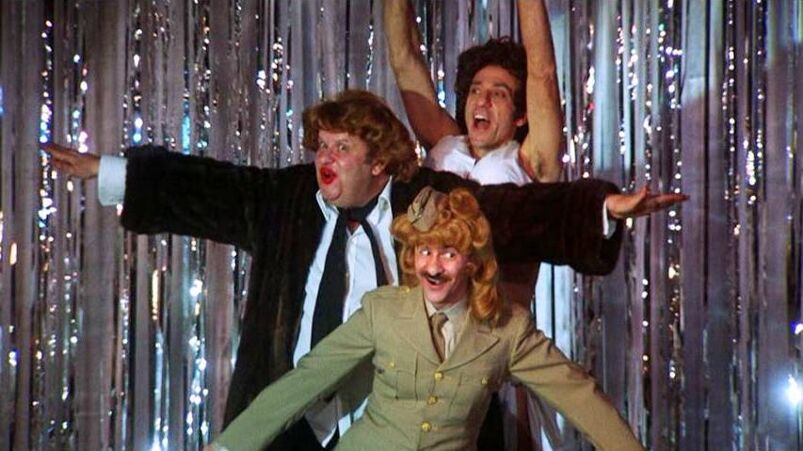
Welcome back to our queer film retrospective, “A Gay Old Time.” In this week’s column, we’re revisiting 1976’s stage-to-screen adaptation of Terrence McNally’s gay bathhouse farce, The Ritz.
Doing a weekly dive into the history of queer cinema (moving through various decades, genres, movie stars, budgets, and countries) has proven to be really eye-opening in terms of tracking which elements of our community have continued to change through the years, and which have remained the same.
Although the public perceptions of queerness (and people that identify within its umbrella) have evolved, what has remained at its center—at least through a cinematic lens—has been an unflinching sense of community and unity; of a group of people that keep looking for and finding each other, creating spaces to co-exist, and bonding both in pain and in joy.
Your dose of fabulosi-TEA
Subscribe to our newsletter for your front-row seat to all things entertainment with a sprinkle of everything else queer.
This week, we take a look back at 1976’s The Ritz, an adaptation of the Terrence McNally play of the same name. It’s a film that, despite being a pure farce at its heart (perhaps one of the least “serious” movies we have covered so far), perfectly captures this aspect of shared queer identity. It simultaneously depicts a type of space that has culturally changed and gone out of fashion today, but also shows an irreverence, wit, and spark in its depiction of gay men that feels familiar and current.
The Set-Up
The Ritz, directed by Richard Lester and written by McNally (adapting his own work), follows one night in the lives of a group of characters in the titular Manhattan gay bath house.
Gaetano Procio (Jack Weston) is running away from his brother-in-law who’s looking to kill him to get rid of his share of the family inheritance, and has to seek refuge in “the last place anyone would look for him.” He’s unaware that this is indeed a place of business that caters to men that enjoy other men, which sets off a chain of misunderstandings and shenanigans worthy of the Looney Tunes.
There, he encounters regular client Chris (The White Lotus‘s F. Murray Abraham), who shows him the ropes and literal ins and outs of the place; lounge singer Googie Gomez (Rita Moreno, reprising the role that earned her the “T” in her EGOT), who mistakes him for a Broadway producer and constantly tries to impress him; Michael Brick (Treat Williams), a young, hunky, Mickey Mouse-voiced undercover private detective hired to follow him, and Claude Perkins (Paul B. Price), a self-described “chubby chaser” that becomes instantly obsessed with Gaetano.
Related:
An Ensemble With Razzle-Dazzle

The film is very clearly an adaptation of a stage play; it’s entirely set in the same location (although Lester works very hard to make it cinematic), with a plot hinges both on a series of mix-ups, confused identities, and double entendres, and on the comedic talents of the cast to deliver the one-liners as theatrically as possible.
It’s not the deepest or most emotionally complex work of art, but it works incredibly well as a screwball comedy, and the talent behind it is clearly giving their all.
Rita Moreno, in particular, is simply incandescent as Googie Gomez, embodying a specific type of gay-adored diva brimming with attitude, bitterness and a body language that makes you instantly see why she earned a Tony for it on stage. If seeing her perform a heavily-accented version of “Everything’s Coming Up Roses” from Gypsy doesn’t immediately put a fire under you, nothing will.
F. Murray Abraham and Treat Williams are perhaps the other two standouts, the former as the embodiment of gay wit and the other as the embodiment of gay desire. Both lean into the ridiculousness of its characters without making them caricatures or stereotypes.
A Peek Into The Bathhouse

Related:
At its core, The Ritz is a fish-out-of-water story; a straight character that unknowingly immerses himself into the chaos and confusion of the gay world (a familiar trope for this column; see William Friedkin’s Cruising for a completely different take on it).
However, the film never places judgment or malice into its gay characters or setting. It understands that The Ritz (and gay bathhouses in general) is a sacred place where its customers come for the privacy, connection, and community that they are unable to find outside, and the value and meaning that it holds for them.
It may also be a quite eye-opening depiction for those that were not alive during the heyday of gay bathhouses, or that only understand them as simply dimly-lit labyrinths of sex and flesh. Yes, The Ritz is remarkably sexually tame for a film set at a bathhouse. But it also shows that these houses were more than just a place to hook up at; they were a place with live performances, and amateur talent nights, and several floors with various types of entertainment, and private rooms decorated with kitschy old Hollywood portraits.
They functioned as a hotel, a club, a drag venue, a restaurant, an athletic club, and a brothel all rolled into one. They contained an entire world of possibilities inside a single building.
The loss of these types of spaces (which do still exist, though are much rarer, and much more contained in size and scope) meant that as time went on, we were able to more easily find privacy, connection and community outside these blacked-out windows.
Related:
Puttin’ On The Ritz
But The Ritz, being so stuck on its time, creates an almost unintentional sense of nostalgia for these institutions. Where you could book a room for the night—twelve hours minimum—in a place where everyone was able to see the real you, dressed down to a towel. Where a fabulous aspiring singer performed Broadway staples with hunky go-go dancers. Where there was an orgy in room 410 happening in ten minutes.
It’s perhaps dubious to romanticize a space that was created out of necessity, because the dangers of the outside world forced us all inside. However, never was the sense of shared community and culture as evident and strong as when everyone gathered in a single space as engrossing as this one.
As time went on, this sense of community was never lost; we just moved it to different places. We compartmentalized them instead of having everything at our disposal under the same roof.
We still have each other, though we may never have another Ritz.
Now available for digital rental or purchase via Amazon Prime Video, Apple TV, Google Play, Vudu, and YouTubeTV.








